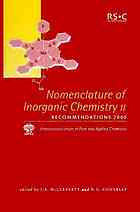
Nomenclature of Inorganic Chemistry II Recommendations 2000 PDF
Preview Nomenclature of Inorganic Chemistry II Recommendations 2000
NOMENCLATURE OF INORGANIC CHEMISTRY II S T N E M E L E E H T F O E L B A T C I D O I R E P C A P U I International Union of Pure and Applied Chemistry Nomenclature of Inorganic Chemistry II RECOMMENDATIONS 2000 Issued by the Commission on the Nomenclature of Inorganic Chemistry and edited by J.A. McCleverty and N.G. Connelly ISBN 0–85404–487–6 A catalogue record for this book is available from the British Library. © 2001 International Union of Pure and Applied Chemistry All rights reserved. Apart from any fair dealing for the purposes of research or private study, or criticism or review as permitted under the terms of the UK Copyright, Designs and Patents Act, 1988, this publication may not be reproduced, stored or transmitted, in any form or by any means, without the prior permission in writing of the International Union of Pure and Applied Chemistry, in the case of reprographic reproduction only in accordance with the terms of the licences issued by the Copyright Licensing Agency in the UK, or in accordance with the terms of the licences issued by the appropriate Reproduction Rights Organisation outside the UK. Enquiries concerning reproduction outside the terms stated here should be sent to the International Union of Pure and Applied Chemistry. Published for the International Union of Pure and Applied Chemistry by the Royal Society of Chemistry, Thomas Graham House, Science Park, Milton Road, Cambridge CB4 0WF, UK Registered Charity Number 207890 For further information see the RSC web site at www.rsc.org and the IUPAC site at www.iupac.chemsoc.org Typeset by RefineCatch Limited, Bungay, Suffolk Printed by Bookcraft Ltd Contents Principal authors of this Edition vii Preface viii II-1 POLYANIONS 1 II-1.1 Introduction 1 II-1.2 Numbering of condensed polyanions 3 II-1.3 Polyanions with six central atoms 6 II-1.4 Polyanions with the Anderson structure 10 II-1.5 Polyanions with twelve central atoms 11 II-1.6 Polyanions with eighteen central atoms 20 II-1.7 Conclusion 22 II-2 ISOTOPICALLY MODIFIED INORGANIC COMPOUNDS 23 II-2.1 Introduction 24 II-2.2 Classification and symbolism 24 II-2.3 Isotopically substituted compounds 26 II-2.4 Isotopically labelled compounds 27 II-2.5 Locants and numbering of isotopically modified compounds 34 II-2.6 Summary of types of isotopically modified compounds 35 II-3 METAL COMPLEXES OF TETRAPYRROLES 36 II-3.1 Introduction 36 II-3.2 The construction of systematic names 37 II-3.3 Trivial names 42 II-3.4 Less common structural types 43 II-3.5 Trivial names of porphyrins, chlorins, chlorophylls, bilanes, fundamental rings and related species 46 v CONTENTS II-4 HYDRIDES OF NITROGEN AND DERIVED CATIONS, ANIONS AND LIGANDS 54 II-4.1 Introduction 54 II-4.2 Parent hydrides 54 II-4.3 Cations 55 II-4.4 Anions 56 II-4.5 Ligands 56 II-4.6 Organic derivatives of the nitrogen hydride ligands 61 II-5 INORGANIC CHAIN AND RING COMPOUNDS 62 II-5.1 Introduction 63 II-5.2 Unbranched chain and monocyclic compounds 63 II-5.3 Branched chain and polycyclic compounds 75 II-5.4 Conclusion 94 II-6 GRAPHITE INTERCALATION COMPOUNDS 95 II-6.1 General considerations 95 II-6.2 Vocabulary 96 II-6.3 Classification of graphite intercalation compounds 98 II-6.4 Non-formula-based description of graphite intercalation compounds 99 II-6.5 Formulation of graphite intercalation compounds 100 II-6.6 Structural notation 101 II-7 REGULAR SINGLE-STRAND AND QUASI SINGLE- STRAND INORGANIC AND COORDINATION POLYMERS 104 II-7.1 Introduction 105 II-7.2 Fundamental principles 106 II-7.3 Recommendations 110 INDEX 126 vi Principal Authors of this Edition Chapter II-1 Y. Jeannin, M. Fournier, France Chapter II-2 W.C. Fernelius, USA T.D. Coyle, USA W.H. Powell, USA P. Fodor-Csányi, Hungary Chapter II-3 R.S. Laitinen, Finland J.E. Merritt, USA K.L. Loening, USA Chapter II-4 J. Chatt, UK R.S. Laitinen, Finland Chapter II-5 R.S. Laitinen, Finland E. Fluck, Germany Chapter II-6 H.P. Boehm, Germany R. Setton, France E. Stumpp, Germany Chapter II-7 L.G. Donaruma, USA B.P. Block, USA K.L. Loening, USA N. Platé, Russia T. Tsuruta, Japan K.Ch. Buschbeck, Germany W.H. Powell, USA J. Reedijk, Netherlands Preface This book is intended to be an adjunct to the first volume which appeared in 1990 and which contains aims, grammar, basic tenets and main classes of nomenclature. For these basic aspects the reader is referred to the primary volume. The current volume is intended to deal with the nomenclature of systems which have specific difficulties with condensed phases such as solids or polymers and where various local nomenclatures have grown up to confuse the practitioners or those entering the fields of research. It addresses such diverse chemistry as polyanions, isotopic modification, tetrapyrroles, nitrogen hydrides, inorganic ring, chain, polymer, and graphite intercalation compounds. It is aimed at bringing order into the nomen- clature of these specialized systems based on the more fundamental nomenclature described in the primary volume and in the organic nomenclature publications. The volume is timely in relation to the growth of inorganic polymers especially and it is hoped that the practitioners will accept the orderly recommendations proposed and use it to simplify the literature espe- cially for the students who now begin to study such systems. The various chapters have been subject to extensive review not only by Commission members but also by practising chemists in the various areas over several years. The evolved chapters should therefore represent a consensus view of appropriate nomenclature for now and some years to come. The Commission is grateful to the external reviewers for their careful and critical comments and support to bring order into the nomenclature of such complex systems. Also, since the topics are largely unrelated and each has an Introduction or Pre- amble, no overall introduction is required and the reader is referred to the first volume for such general comments on nomenclature. 1st July, 2000 A S H D. K Chairmen, IUPAC Commission of the Nomenclature of Inorganic Chemistry
